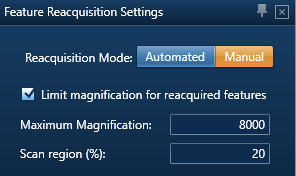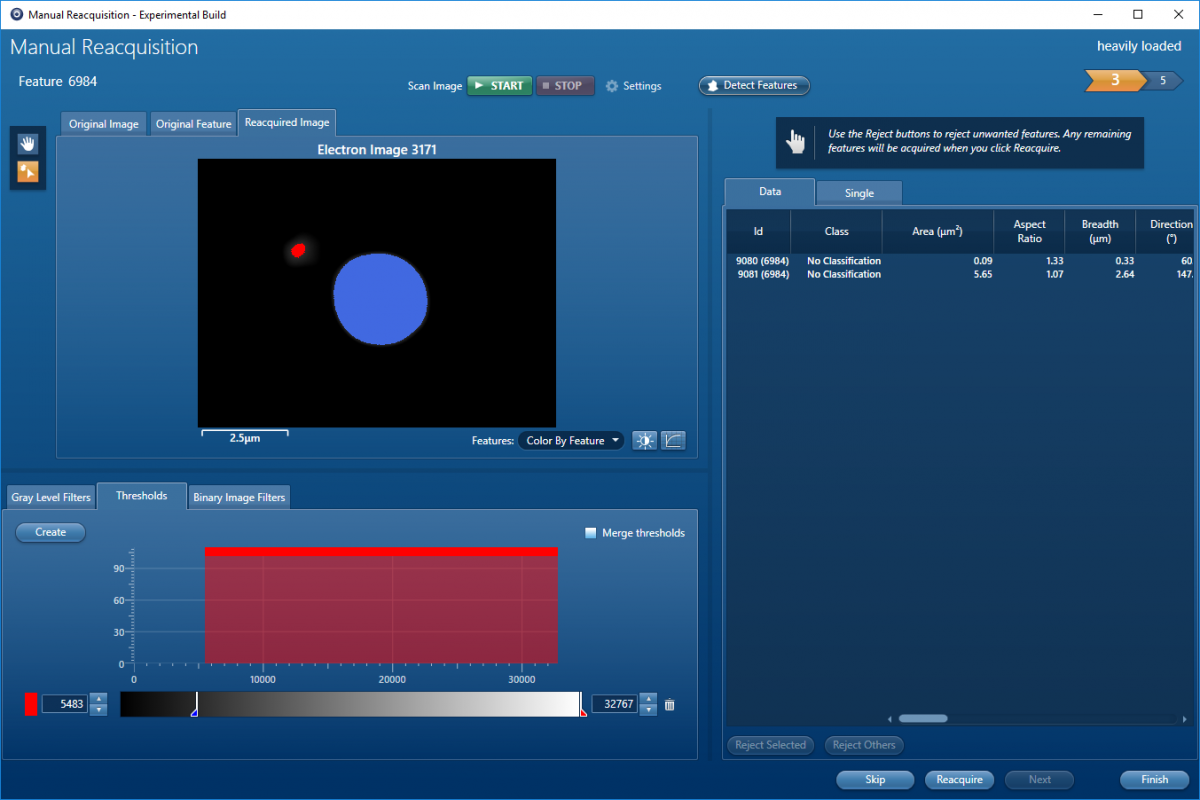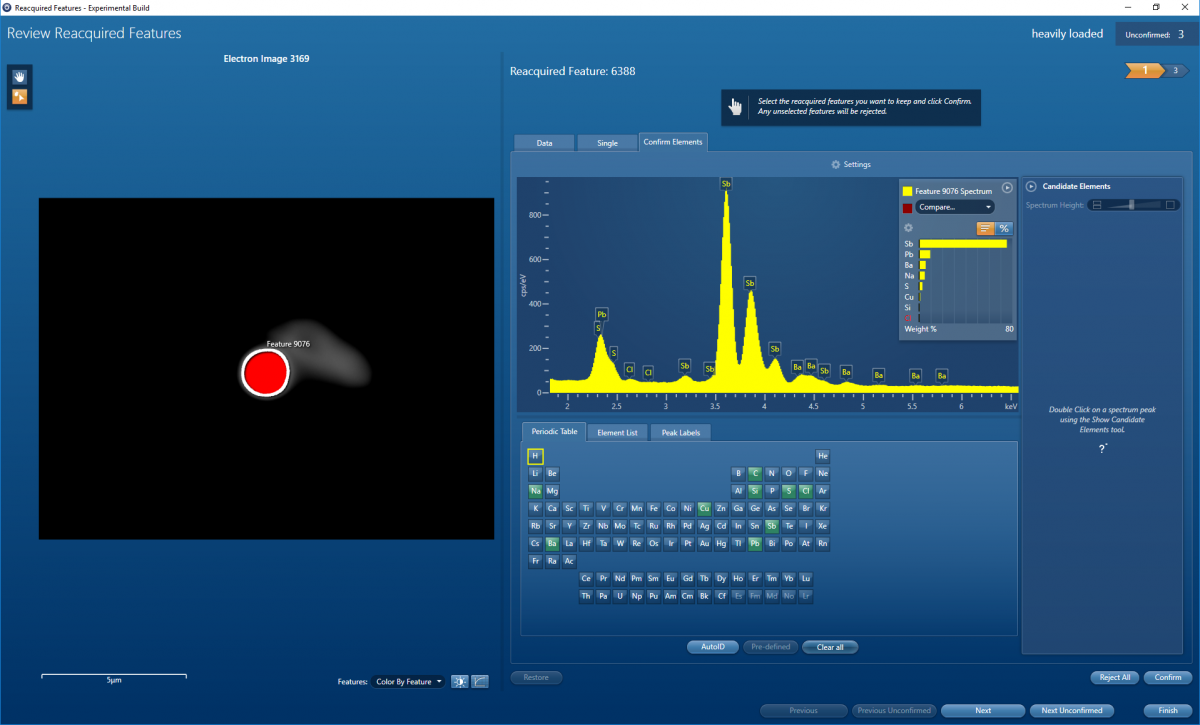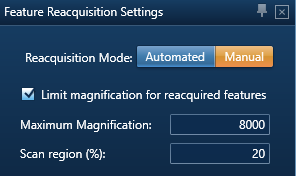Manual Particle Reacquisition: an Application Example for Gunshot Residue (GSR) Analysis
In many research areas there is a requirement to get a quick overview of the features present in a large sample in order to identify features of interest (i.e., finding the needles in the haystack), and then to focus in on these to conduct a more in-depth investigation. This can be easily achieved if fast, automated analysis is run over a large sample area, and then features of interest can readily be identified and returned to for manual reacquisition.
We have developed a flexible workflow in our particle analysis software, AZtecFeature, that allows you to automatically image and analyse particles over a large sample area/multiple sample areas and then return to key particles of interest to manually (re)acquire (or automatically if desired) higher quality electron images and compositional (i.e., EDS) data. Here I shall discuss a specific application example for Gunshot Residue (GSR) analysis, using AZtecGSR, an application specific software solution that sits inside AZtecFeature.
Firstly, what is GSR?
Gunshot residue (GSR) is formed by the condensation of vapour derived from the bullet primer when a gun is fired. These particles are typically spherical, have a range of sizes, and have a characteristic composition depending on the type of ammunition used. When a gun is fired GSR is likely to land on the shooter, as well as other persons/objects present. The identification of GSR in samples collected from suspects by law enforcement can be used to link individuals to a shooting. The information required (compositional and morphological) can be collected on a scanning electron microscope (SEM) combined with an energy dispersive X-ray spectroscopy (EDS) system. This information is often presented as key forensic evidence in criminal court cases and therefore a strict working standard must be followed. This includes the requirement for GSR particles to be manually imaged and analysed by a trained GSR analyst, and not an automated system – hence the ability to manually reacquire is a must.
A specific user workflow is needed for GSR, and other types of particle analysis, to be time-effective and consistent. The workflow for AZtecGSR (and AZtecFeature) consists of the following steps:
- Optimise SEM imaging settings for particle identification (e.g., BSE contrast and brightness, for which an imaging standard can be provided with the system)
- Set up thresholds and filters to detect particles based on the electron image
- Set EDS analysis settings and test these (and the thresholding settings) on a small sample area (e.g., ~100 particles)
- Select a classification scheme (e.g., international standard ASTM E1588-17) to classify the particles against
- Automatically collect SEM images and EDS data from a large number of particles on a sample/multiple samples
- Identify and select particles of interest from the automatically acquired data
- Return to and re-image/analyse particles of interest through the inbuilt wizard for manual reacquisition which allows the analyst to optimise magnification, imaging, thresholding, filtering and EDS data acquisition settings
- Interrogate and confirm the reacquired data using an inbuilt wizard for reviewing reacquired features
- Export and/or report the (re)acquired data
Steps 7 and 8 address the new functionality for manual particle reacquisition and I shall now go through these in more detail.
Once particle data has been acquired from a large sample(s) area, the data can be sorted and specific particles of interest selected from the table. To manually reacquire images and EDS data from these particles ‘Manual Reacquisition’ needs to be selected from the drop-down menu (Fig. 1).

Figure 1. Settings for reacquiring features.
Once reacquisition is started the inbuilt wizard (Fig. 2) will be brought up and the SEM stage will automatically move to the first particle of interest in the list. If more than one particle appears in the field of view the correct particle can be identified by comparing the originally acquired image with the particles in the field of view. Settings such as magnification, contrast/brightness, thresholding, filtering, and EDS analysis conditions can then be optimised on a particle by particle basis; the inbuilt wizard with automatically move through/to the selected particles in order.

Figure 2. Inbuilt wizard for Manual Reacquisition.
Once electron images and EDS data have been reacquired from the particles of interest, the data can be interrogated and confirmed. In an inbuilt wizard for reviewing reacquired features (Fig. 3) images and EDS data can be viewed and analysed in more detail and reacquired data included/excluded from the data table, and ultimately the final report.

Figure 3. Inbuilt wizard for reviewing reacquired features.
This new functionality for manual reacquisition and confirmation in AZtecFeature allows the trained analyst to acquire high resolution electron images and high-quality EDS data from specific particles of interest, identified in the results from an automatic run over a large sample(s) area. In the case of GSR analysis this allows the working standard to be met and enables the strongest possible forensic evidence to be gathered and presented in a court of law.
To find out more about the particle reacquisition power of AZtecFeature and AZtecGSR:







